Welcome to the set-piece roundtable! Each month, we will travel to new leagues and nations worldwide to bring to the limelight the most exciting and innovative tactical set-piece tweaks/ideas or any routines that stand out. These ideas will range from highly effective to ineffective, but we will inform you of the thought processes behind these routines to determine if there is room for these set plays to be repeated in the future.
For the inaugural roundtable discussion, we head to Serie A to find the most creative set-piece solutions that Italy has to offer. Some teams in the league have been extremely rigid and unadventurous with their set pieces, and this top seven will hopefully provide the rest of the league with some inspiration for set-piece routines to try and recreate.
In this tactical analysis, we will look into the tactics behind Serie A’s most interesting set pieces, with an in-depth analysis of why each routine is used. This set-piece analysis will examine why each routine has been refreshing to watch, detailing how and when the different routines are most efficient.
7) Escorting the Ball to the Goal, UDINESE vs Lazio – Attacking Free Kick
Like in the image below, free kicks from wide areas along the edge of the penalty area are one of the most dangerous set pieces a team can have. The area around the corner of the penalty area is at an angle where a cross can be aimed towards the goal, where players have the opportunity to attack the ball, but even if the ball misses every player, it ends up as a shot on goal.
Goalkeepers aren’t able to react until the ball passes the potential attacking unit, which is often placed around the six-yard line, so even if they see a cross heading towards their far post, they cannot dive until they are sure the ball won’t have any more contact made.
As a result, goalkeepers have almost no time to react, making set-pieces from this position extremely difficult to save, as long as the cross makes the keeper ask the question: will someone get another touch on the cross?
Of course, crosses that are overhit or direct shots on goal instantly provide the goalkeepers with the answer, but the intent should be to make the goalkeeper unsure of the answer until the ball reaches the six-yard box.
From the position Udinese have the free kick from, the chance of a cross going towards goal is lowered due to the angle and presence of a wall. However, in order to combat this, Udinese split the wall by using a decoy attacker, who deceives the opposition by appearing to want the ball played short. As this movement is made, the nearest player, who is in the wall, steps out to be ready to close down the ball, but in doing so, has left the wall weaker and provided the taker with an angle at which he can cross the ball and it remains on track for goal.
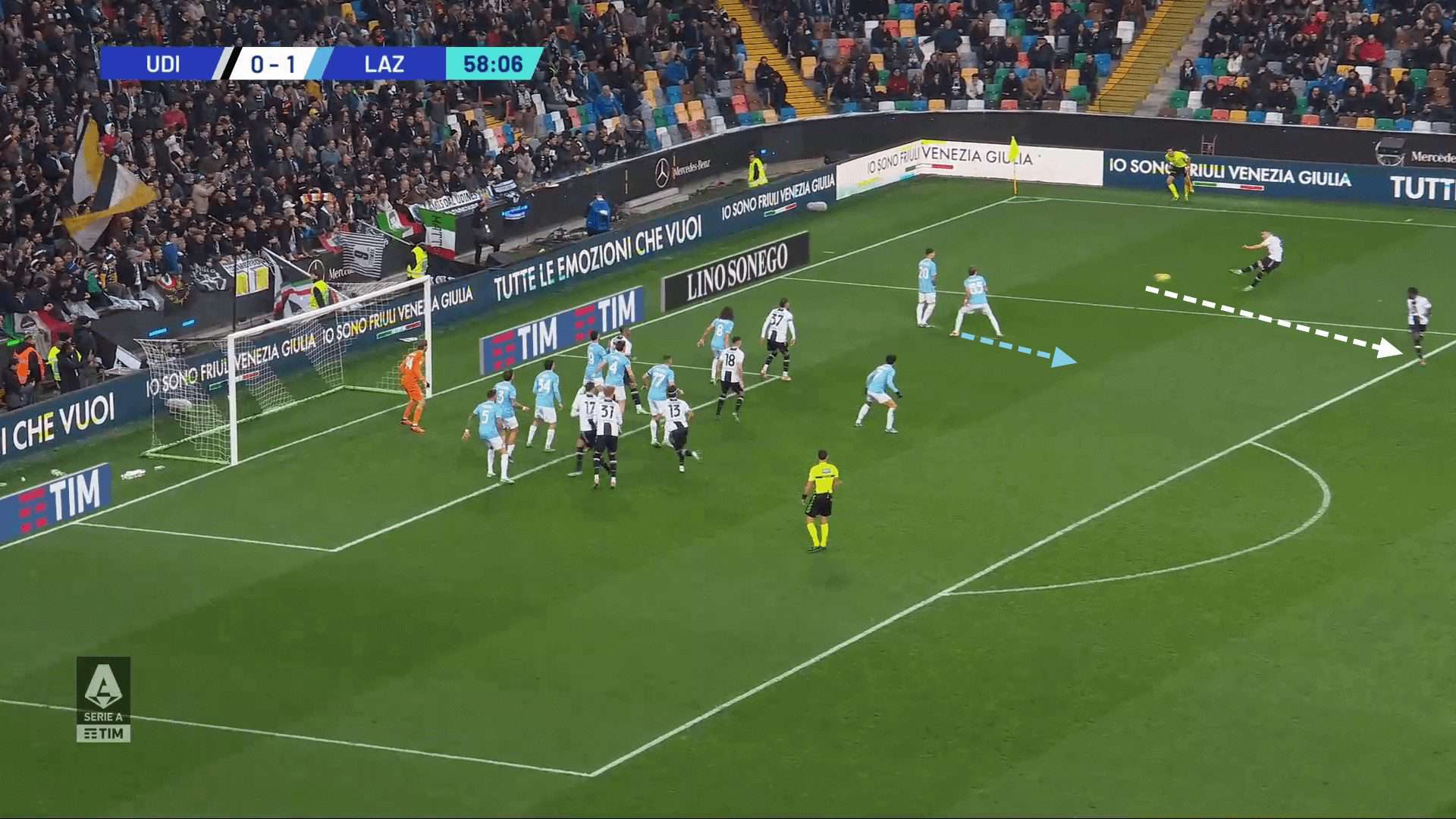
This is relatively similar to many free kicks from this position; a cross is heading towards the back post. Usually, with a wider angle, the ball is attacked by players from the far side of the attacking unit, attempting to win the header. In this particular case, and at an extremely narrow angle, if the ball is to head goalward, it must pass the near side of the attacking and defensive units.
The image below shows the path the ball will take.
With this in mind, only two potential defenders can get rid of the ball while the remainder of the defensive unit is focused on other attackers. With only two defenders to worry about, Udinese have fewer players to worry about, and there is less chance of an error. The decoy run highlighted below dragged the nearest zonal defender away from his position. He makes a move towards the ball, across its path, meaning both the defender and goalkeeper need to be more aware.
The next defender is immobilised through the use of a screen, where the attacker sets himself in front of his marker, preventing him from being able to attack the ball. This clears the path for the ball to reach the bottom corner of the goal, with no defender having much chance of making contact with the ball.
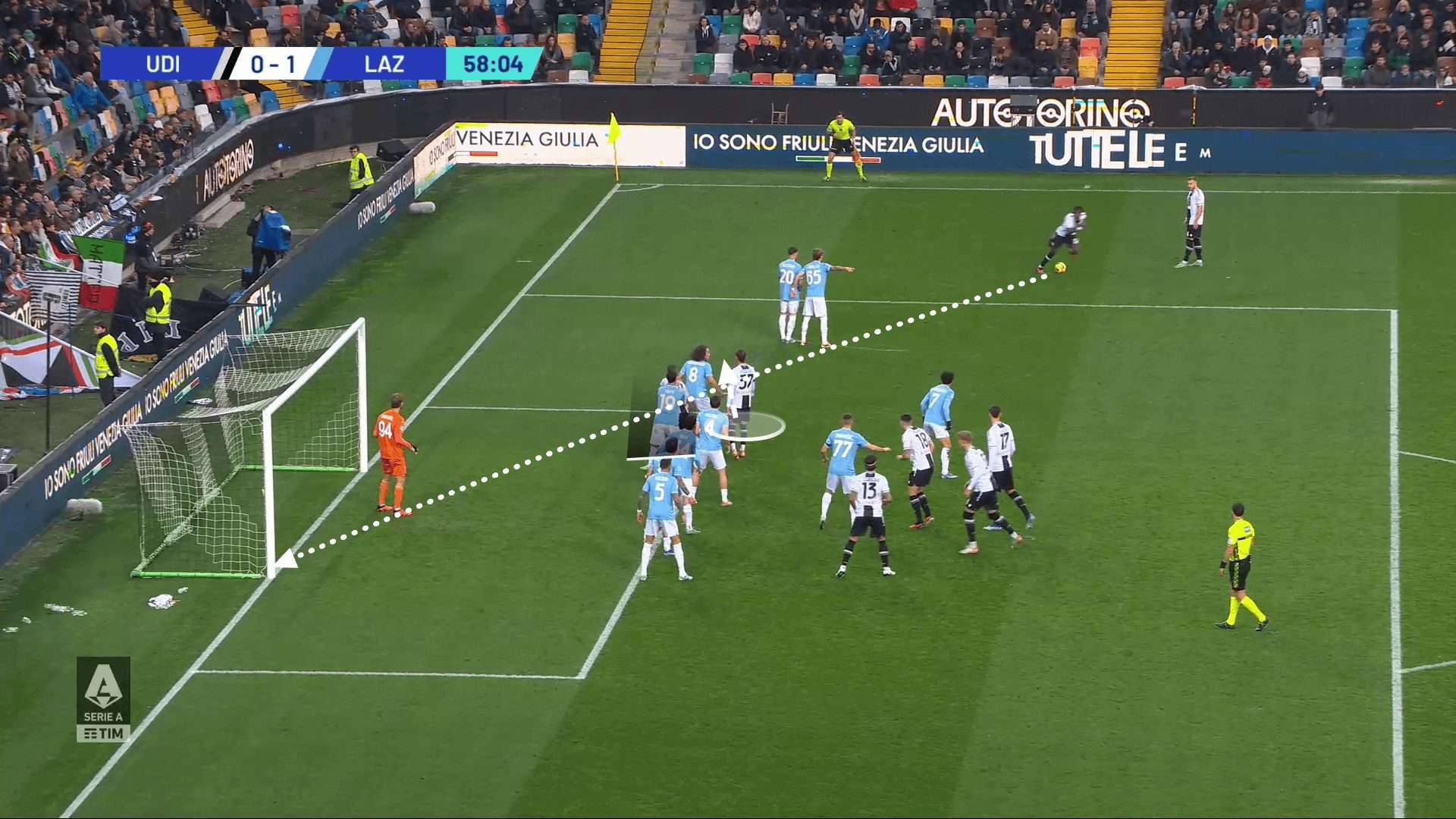
6) Heavy Zonal Setup, GENOA vs Lecce – Defending Corner Kick
Genoa have one of the stronger defensive setups from set-pieces, stats-wise, with only four goals conceded. Something interesting they have done at points this season when defending corners is to focus on protecting the zones closest to their goal, only allowing players space around the penalty spot and greater distances. The image below shows this system’s starting positions.
They use six players inside their six-yard box to ensure no attacker finds space in a position close to goal. In order to combat any attackers arriving in the six-yard box from deep with momentum, they used three defenders, who marked attackers as they passed through their zones, disrupting their runs to the six-yard box.
This approach does leave Genoa vulnerable to any short corners or headers from deep, as well as potentially being on their heels when chances come through flick-ons or in the second phase, but Genoa ensure that the opposition never creates a clear-cut chance for the first contact in the six-yard box.
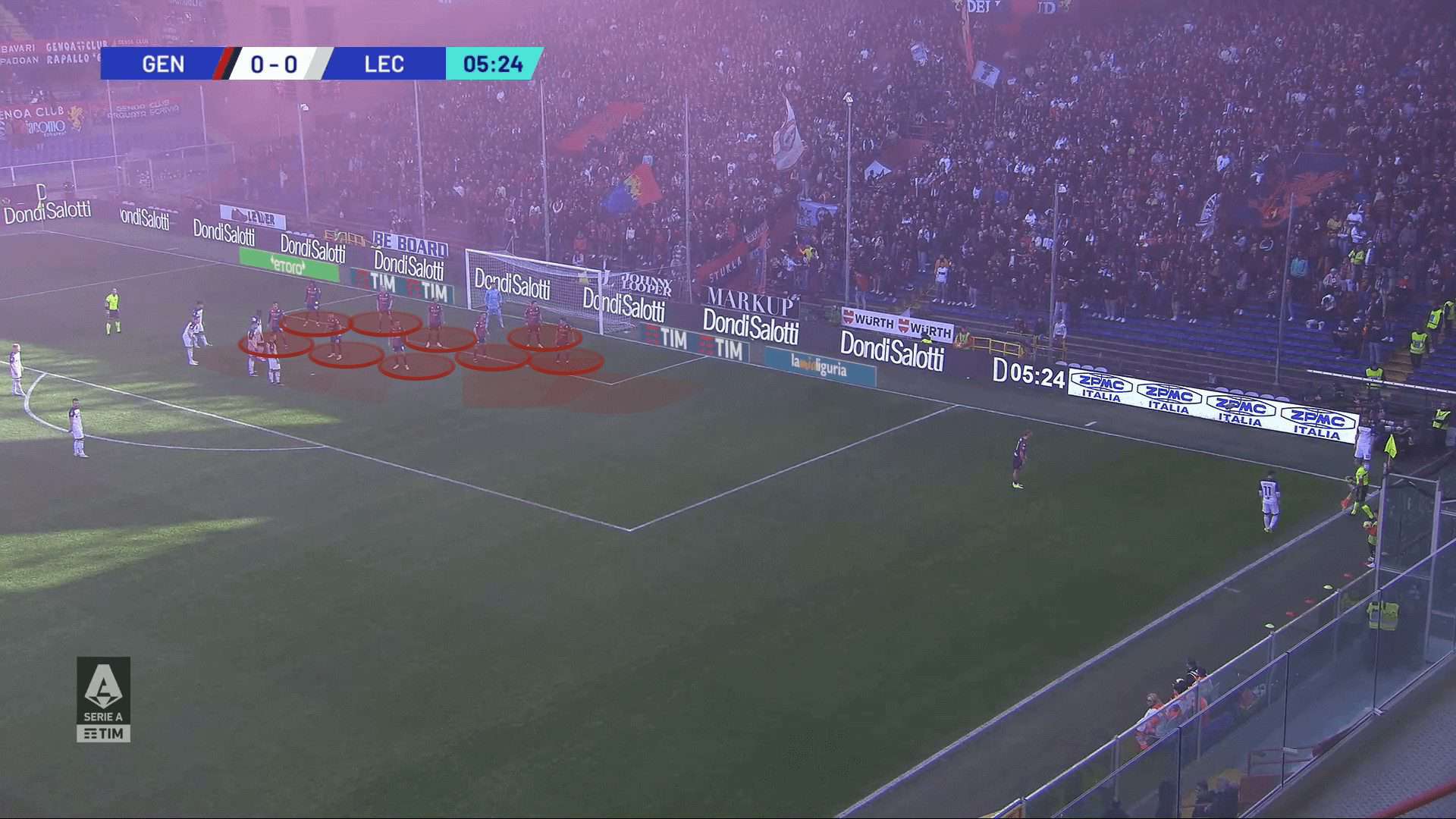
5) Deep Runs to Dominate Zonal Defenders, FIORENTINA vs Frosinone – Attacking Corner Kick
As mentioned above, a potential solution to facing a zonal defensive unit is to use a run from deep to generate momentum to gain the advantage in the aerial duels. In the previous examples, Genoa used extra defenders to disrupt the runs of those players, ensuring the zonal defenders had maximal protection. However, as we see in the image below, the Fiorentina players can make runs towards the six-yard box without disruption.
There is a defender in between the target area and the attacker’s starting position, but his body orientation is facing the ball, not the attacker. This gives the attacker an easy chance of entering the six-yard box and evading the defender in the way by simply stepping to either side. Sometimes, defenders may choose to start extremely tight to their opponent to prevent them from getting a run-up, but in the cases where space is offered, the run from deep can be a straightforward solution to beating a zonal unit.
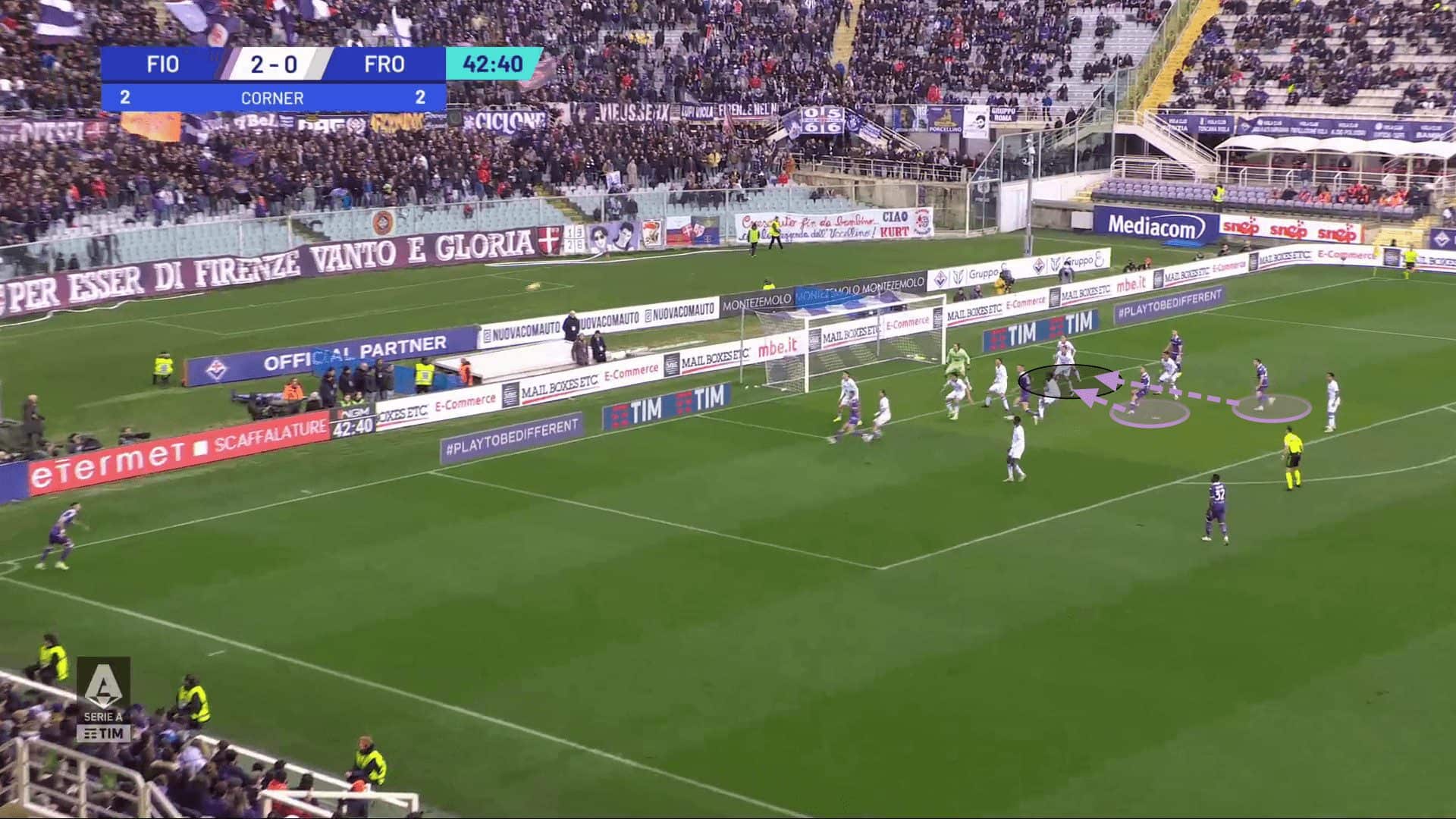
We can see in the next image that with the ability to use a six-yard sprint, the attacker is able to jump to a much higher level than the static zonal defenders in front. The zonal defenders in both images are only focused on the ball, with their body orientation exclusively towards the corner taker.
This means they cannot see the oncoming attackers and cannot prepare themselves adequately for the aerial duels. The attackers, who can see both the ball and the defenders, can jump early, before their opponent, simply by seeing when they are preparing to leap for the ball. That early jump can help them pin the defender to the floor, immediately enhancing the chance of them winning the aerial duel.
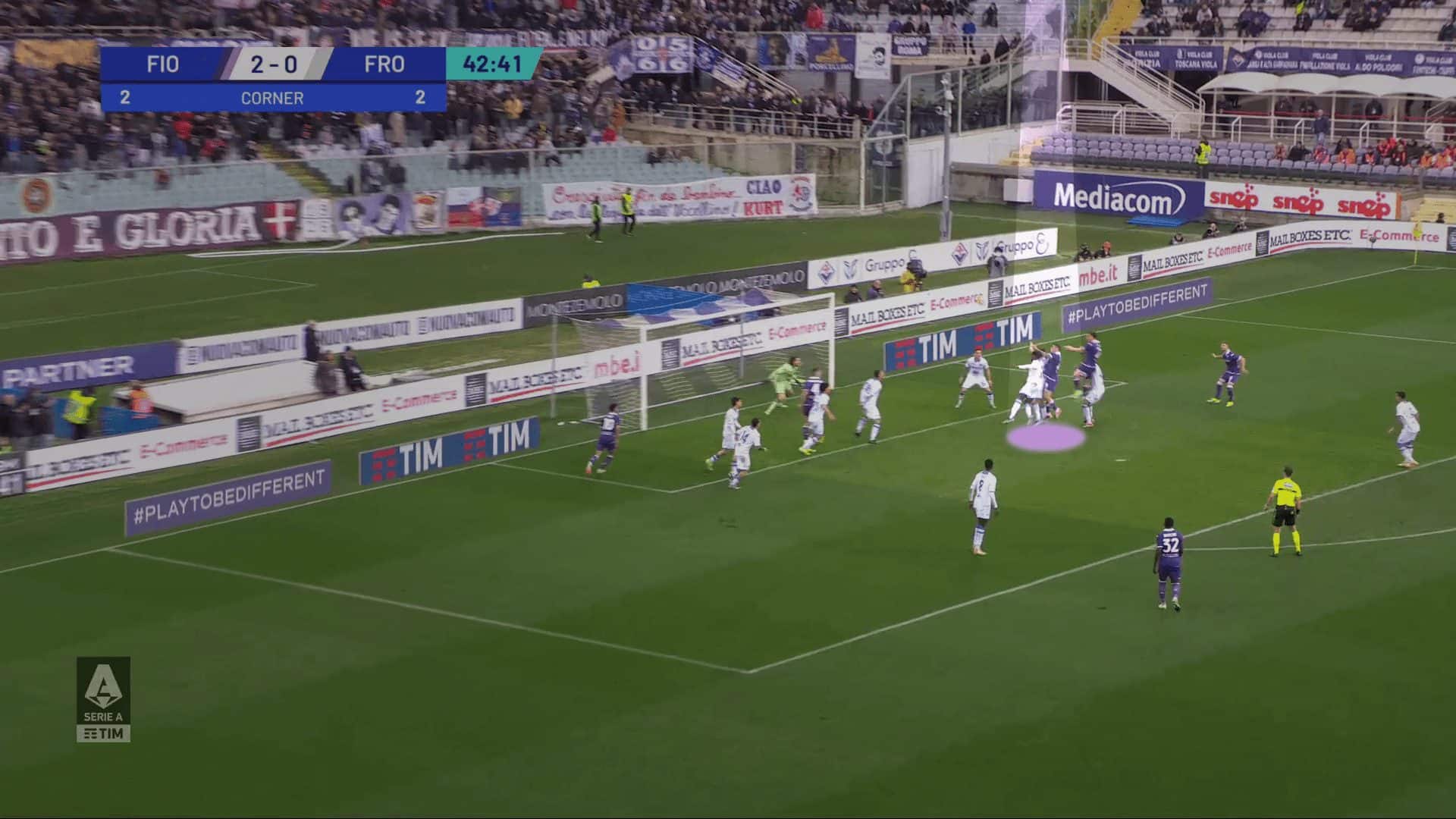
4) Sneaking in at the Front Post, Fiorentina vs INTER – Attacking Corner Kick
In the top four of the most innovative set-piece routines, we can see a common theme amongst the defensive side. The majority of these final examples all occur against Fiorentina’s man-to-man approach to defending corner kicks.
When a team defends using man-marking, they rely on each individual being able to defend an ample open space, with little to no defensive cover if any player loses their marker.
The image below shows the black area as the only part of the penalty area with any cover. Every other defender is vulnerable to losing their marker, whether it is through a screen or a quick movement. When space is on offer, the attacking side will always have the advantage.
With the nature of corner kicks crossing the ball into high-value areas, only one attacker needs to lose their marker and meet the ball to convert the opportunity into a goal. The defensive side doesn’t know which of the five or six attackers the cross will be aimed towards or where it is headed, meaning there are potentially four decoys inside the penalty area who aren’t intending to attack the ball.
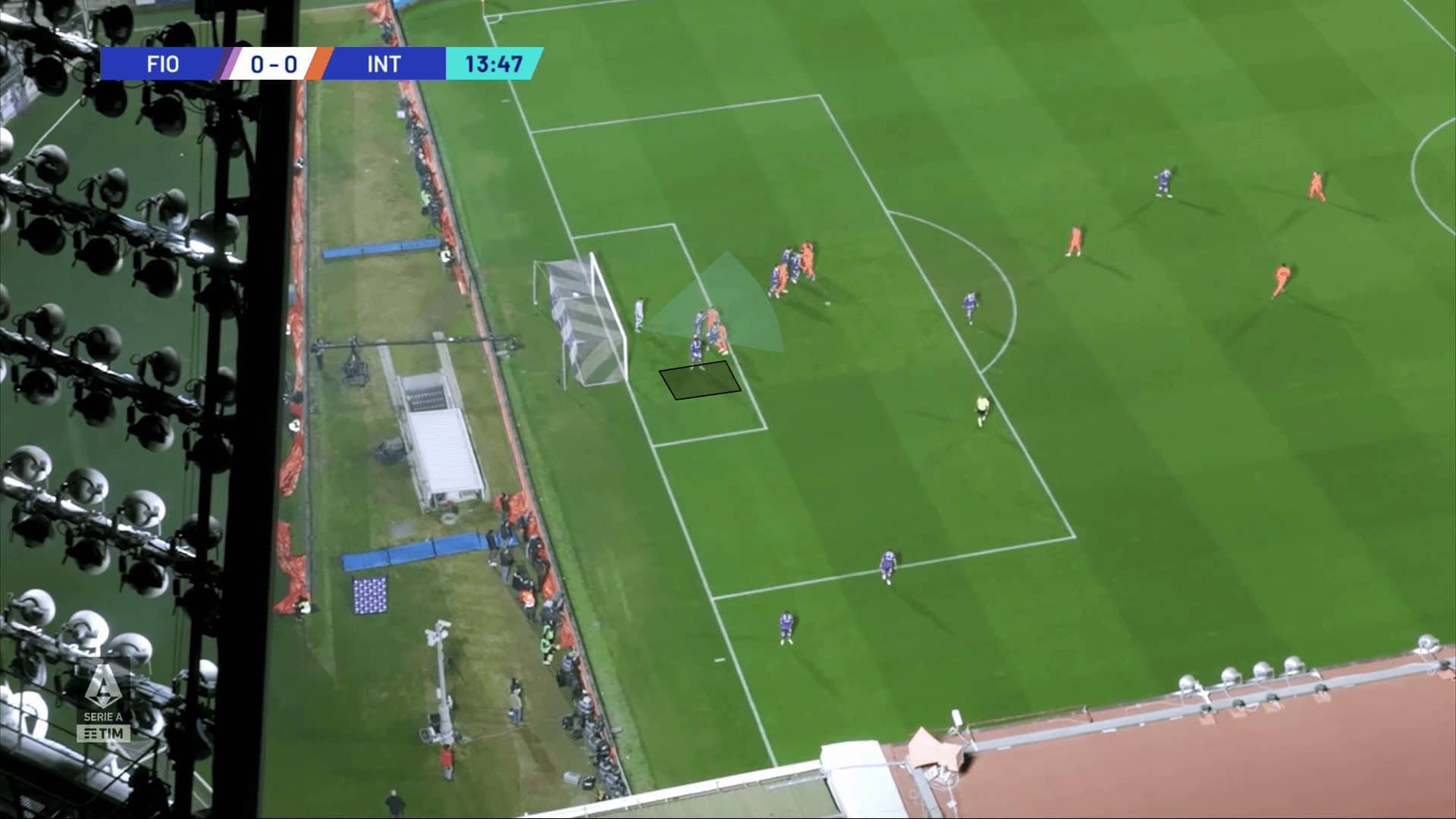
In Inter Milan’s case, Lautaro Martinez is the player aiming to attack the ball in the space in front of the zonal defender. The space in front, even though the angle may be tight, still has a good enough angle for the attacker to be able to redirect the ball into the goal whilst the goalkeeper is in the middle of the goal, under the assumption the near side of the six-yard box has cover.
With the target area and target player pre-determined, Lautaro Martinez has one task left to ensure he makes contact with the ball: arrive unmarked. There are numerous ways to achieve this, but with so much space available, he easily loses his marker. He positions himself in a spot where he can attack the space directly while his marker can’t. We can see from the image that he has a clear path to the ball, whilst his marker must run around Martinez’s teammate, giving him the separation needed to arrive unmarked.
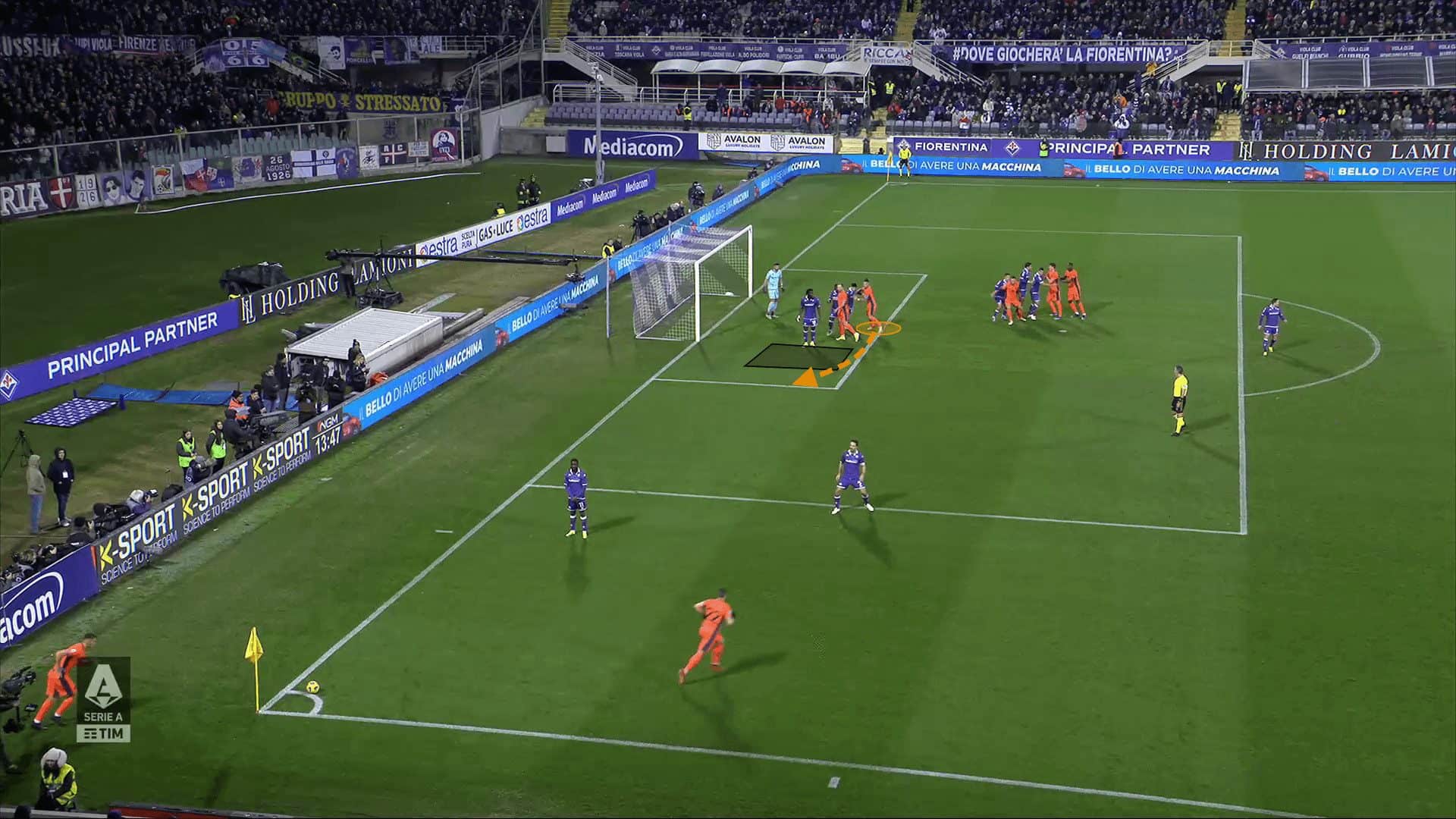
3) Flick-on to the Back Post, Hellas Verona vs FROSINONE – Attacking Corner Kick
Different zonal defensive setups have slight variations in the areas that defenders are supposed to cover and whether defenders should be player or ball-oriented. In the example below, we can see that Hellas Verona, the defending side, use a zonal defender on the near side of the six-yard box, as well as four players within the width of the goal on the six-yard line. The nearest of the four zonal defenders is quite deep and has his body oriented to the attackers, but he cannot see both the ball and the player at the same time. The deeper positioning of the zonal unit gives Frosinone the opportunity to attack the near edge of the six-yard box, which neither of the zonal defenders is responsible for.
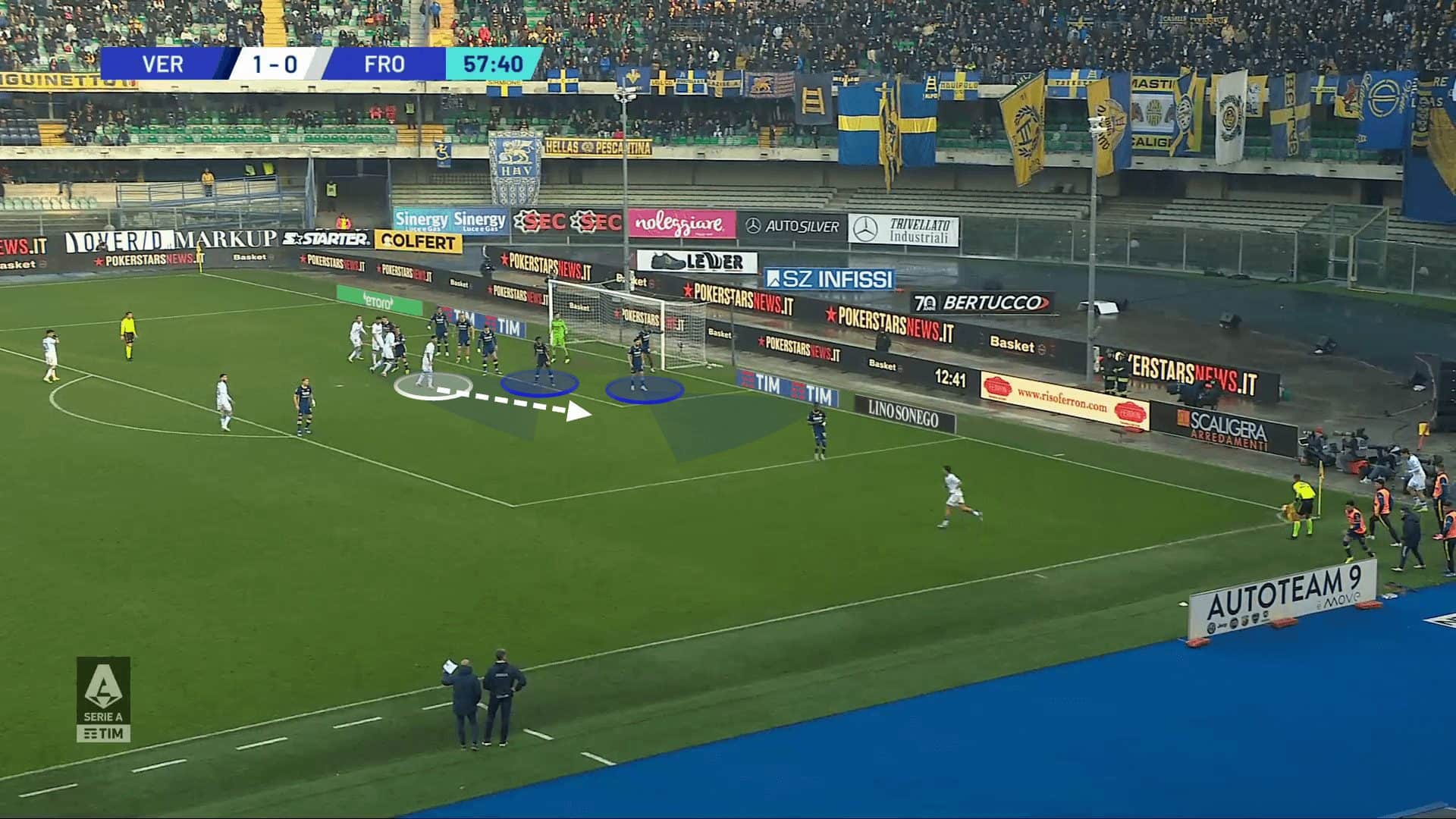
As the nearest zonal defender has trouble keeping an eye on two things at once, the attacker can arrive in the area unopposed, from where he can complete a flick-on. When teams defend zonally and deep, the extra touch before a second contact is made is crucial to creating the space inside the six-yard box that originally didn’t exist.
Defenders naturally edge forward toward the ball to anticipate the space in front of them, but as the defenders focus on the ball, the attackers are able to ghost in the space behind the defenders. We can see in the image below the attacker moves towards the back post, whilst the defender who was originally in his path went to mark the player he could see in front of him, leaving the eventual goal scorer a clear path to the goal.
This is particularly effective against teams who used defenders to mark the post, where there is no risk of offside, making the timing of each action easier to achieve.
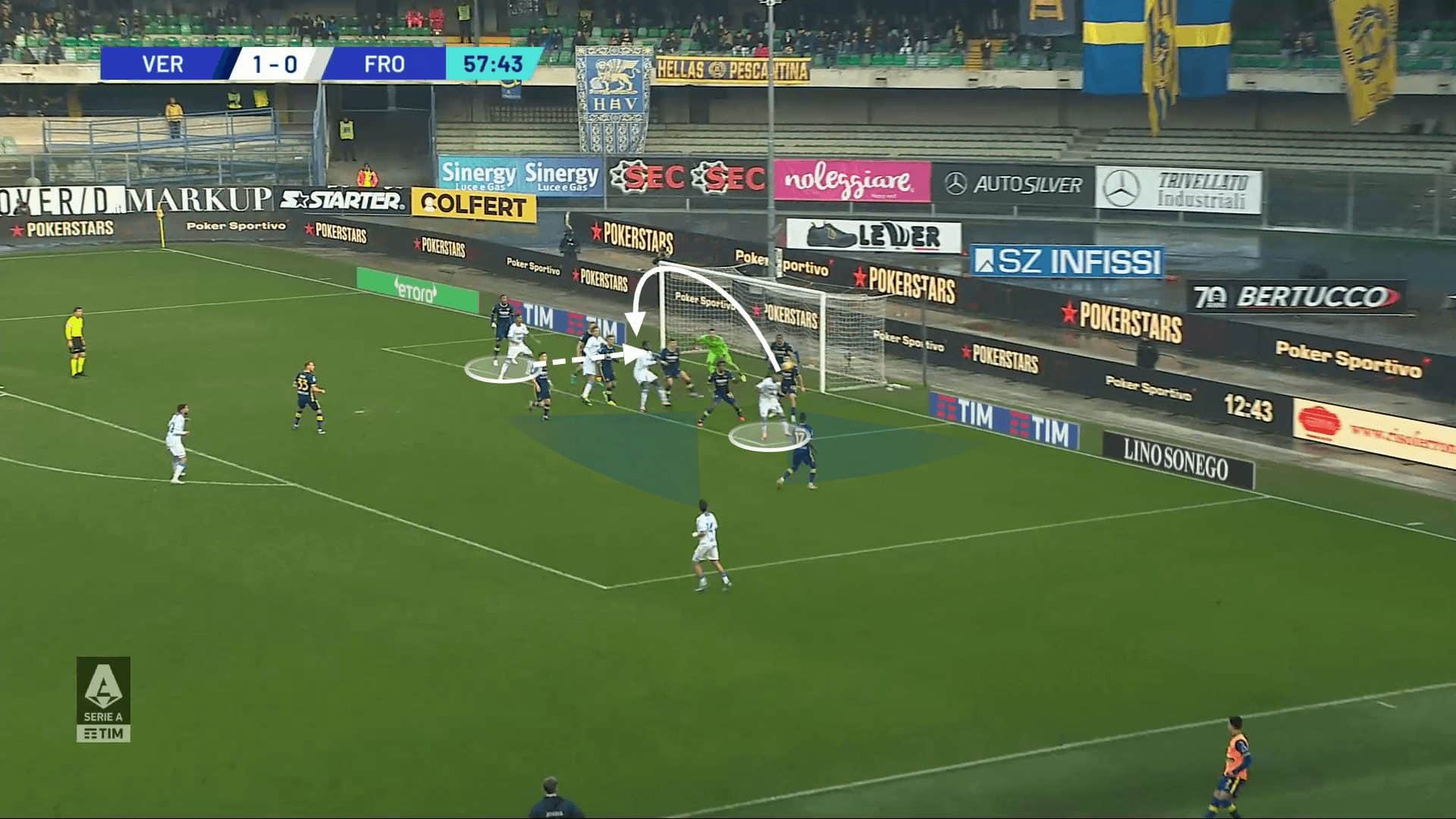
2) Peel to the Back Post, LECCE vs Fiorentina – Attacking Corner Kick
Coming up against a man-marking defensive approach yet again, we can see Lecce with a 4v4, whilst there is one zonal defender inside the six-yard box. Yet again, teams playing against Fiorentina can choose where the cross will be delivered and have a much higher chance of being successful due to the ease at which attackers can lose their marker.
Like Inter Milan, all that is required is for the attacker to position himself in a spot where he can attack the target area directly, whilst his marker has no clear path to the target area. Eventually, a chance is created following a headed effort from 12 yards out.
The remaining attackers all make moves away from the back side of the six-yard box to create more space for the target player, meaning that no defender has the possibility to cover the space that will be exploited.
The deeper positioning of the headed effort means the shot was harder to result in a goal, but Lecce have been able to gain access into the penalty area, from where many different options are available in the future.
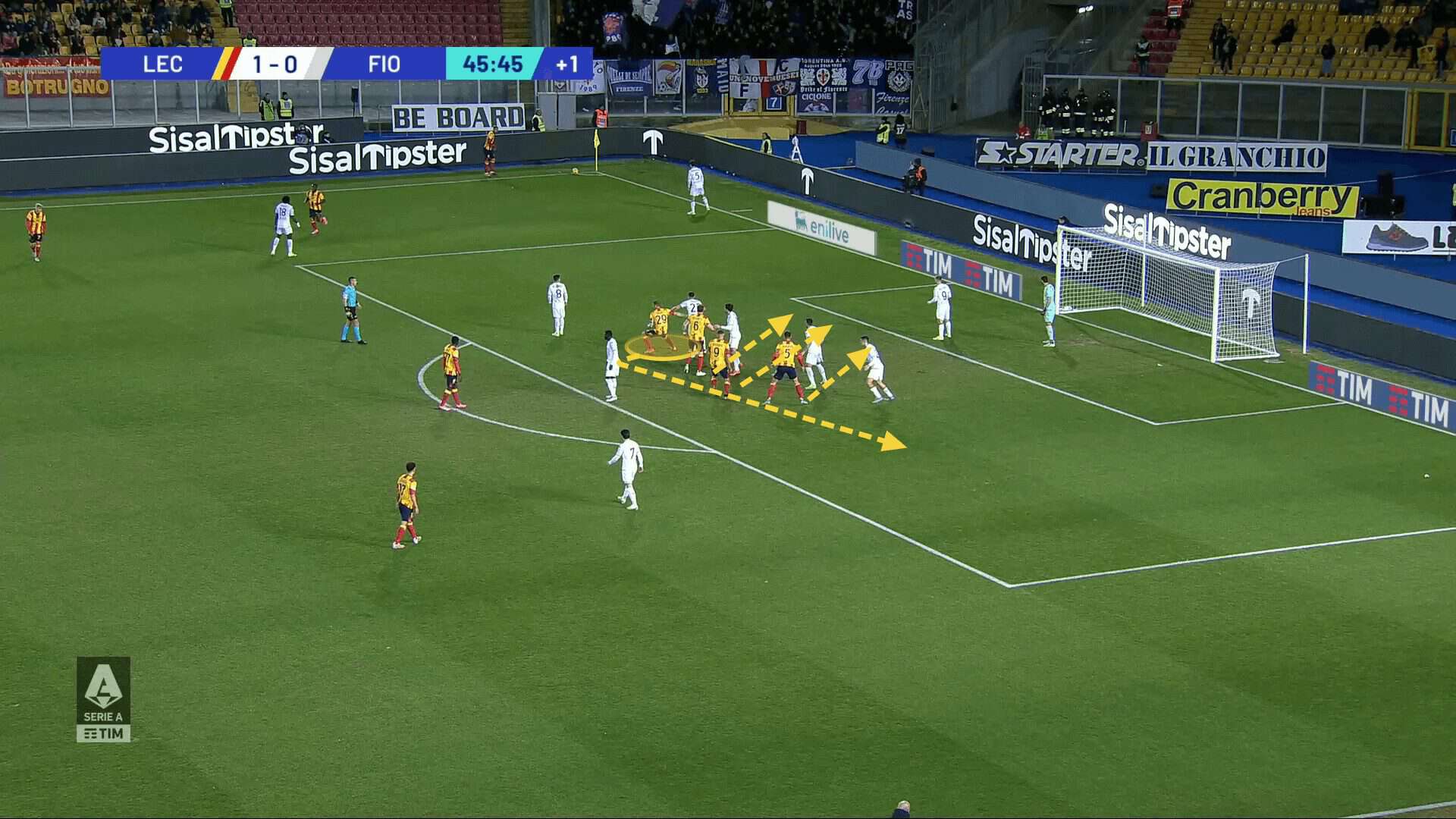
1) Ripping Apart a Man-Marking Structure, SASSUOLO vs Fiorentina – Attacking Corner Kick
The most interesting routine used has been created by Sassuolo, who yet again prove how easy it can be to rip man-marking systems apart. Each defender is like a puppet being pulled by the string by the attackers, who are able to manipulate the position of every player through their movement.
As we see in the example below, there is one zonal defender while the rest man mark, leaving the middle of the six-yard line completely unmarked.
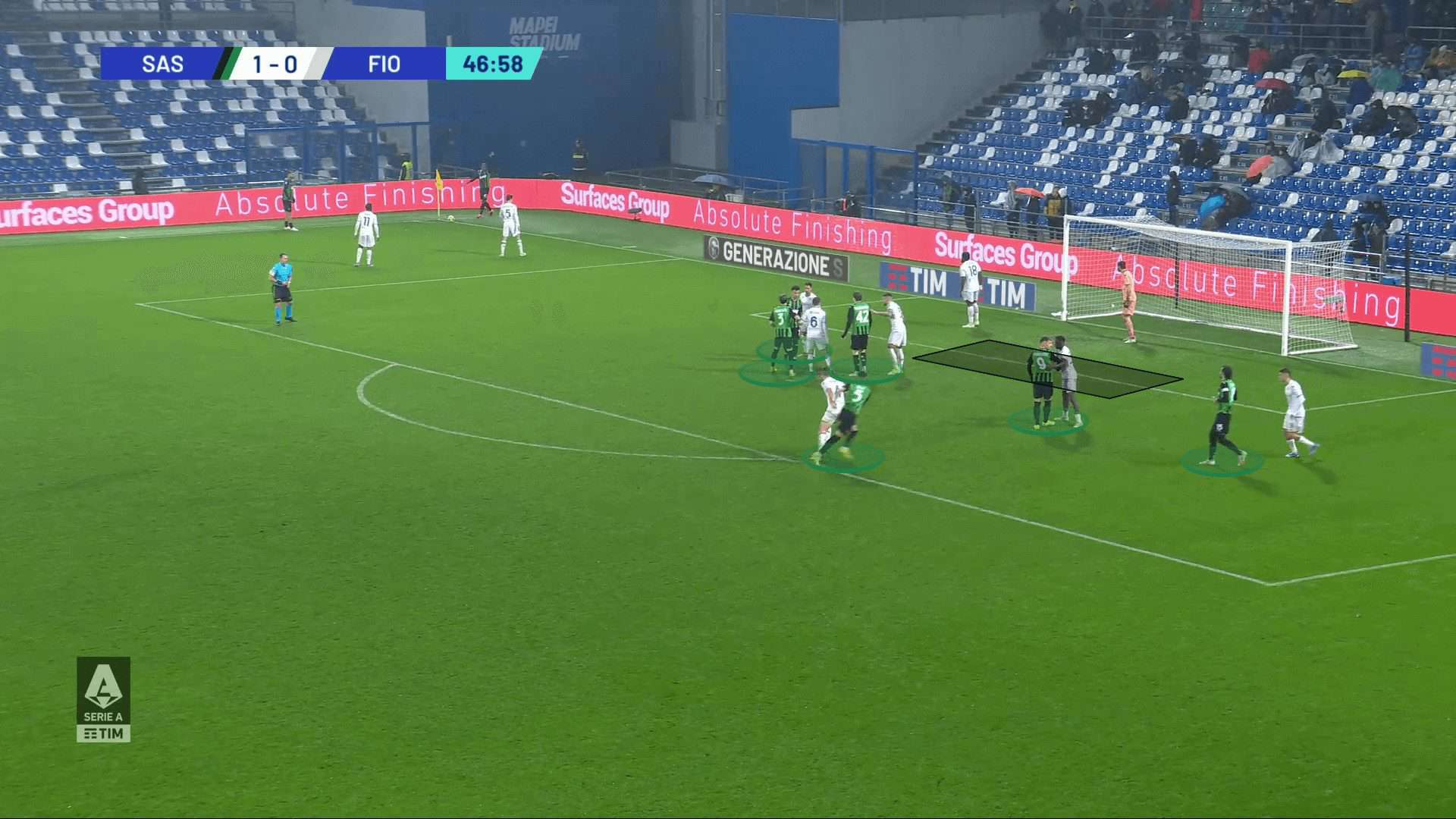
The area highlighted is the area that has been pre-determined by Sassuolo to attack, and all that is left is to ensure a player can arrive in the area unopposed. In order to create as much space in the six-yard box as possible, a series of decoy runs are made, as shown in the example below.
Each player moves away from the area to give the corner taker as much room for error so that the attacker can have time to readjust even if it is under-hit or overhit. One attacker also makes the run between the target area and the goalkeeper to ensure that the goalkeeper cannot claim the cross.
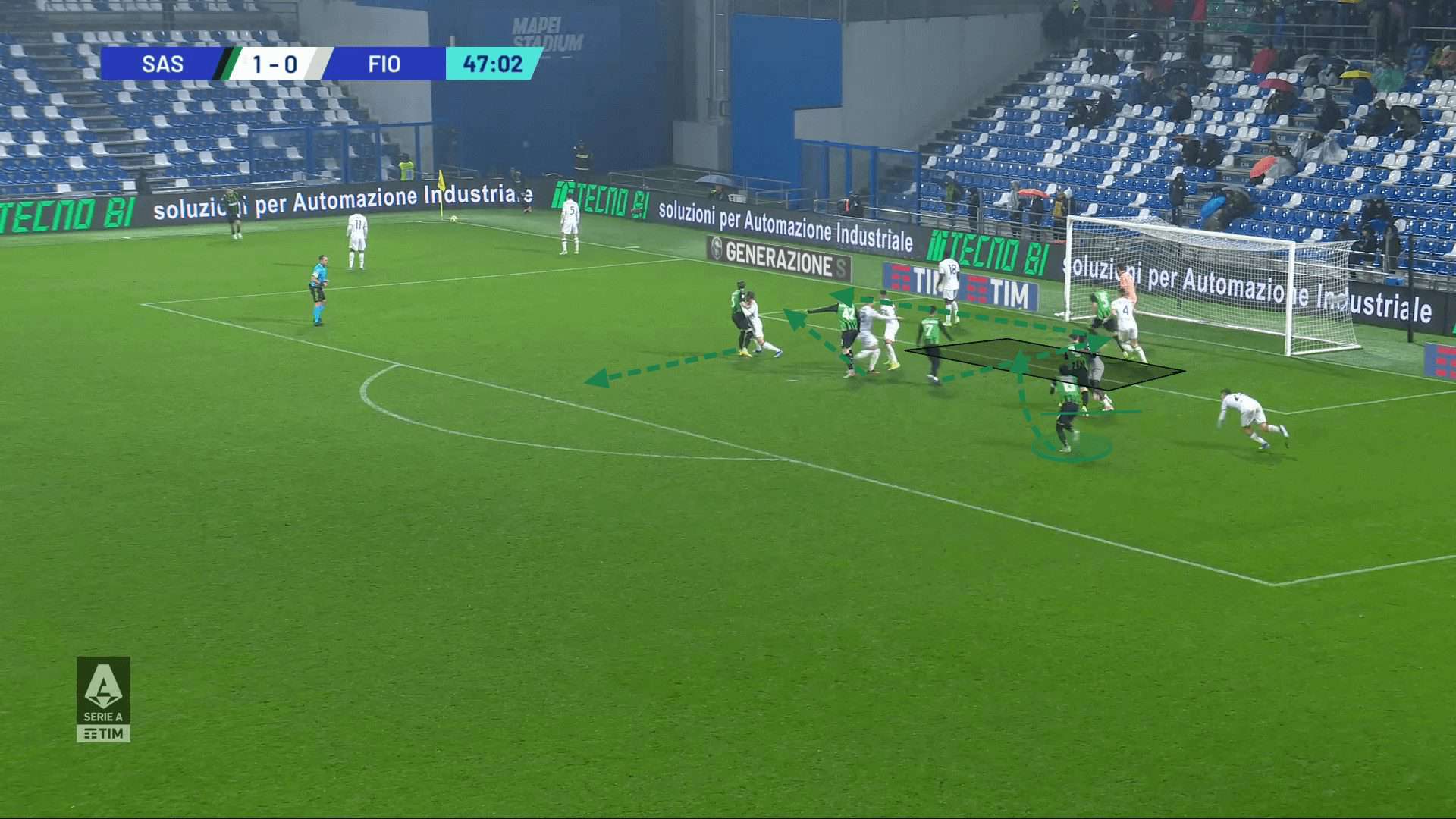
The target attacker uses his teammate and his marker as a screen to run around, giving himself the separation needed from his original marker, which leaves enough space for the attacker to arrive in the six-yard box by himself.
The chance ends with a shot from around six yards, which results in the ball hitting the back of the net following the second phase, although later being disallowed for offside by a player who doesn’t appear to be involved in the play.
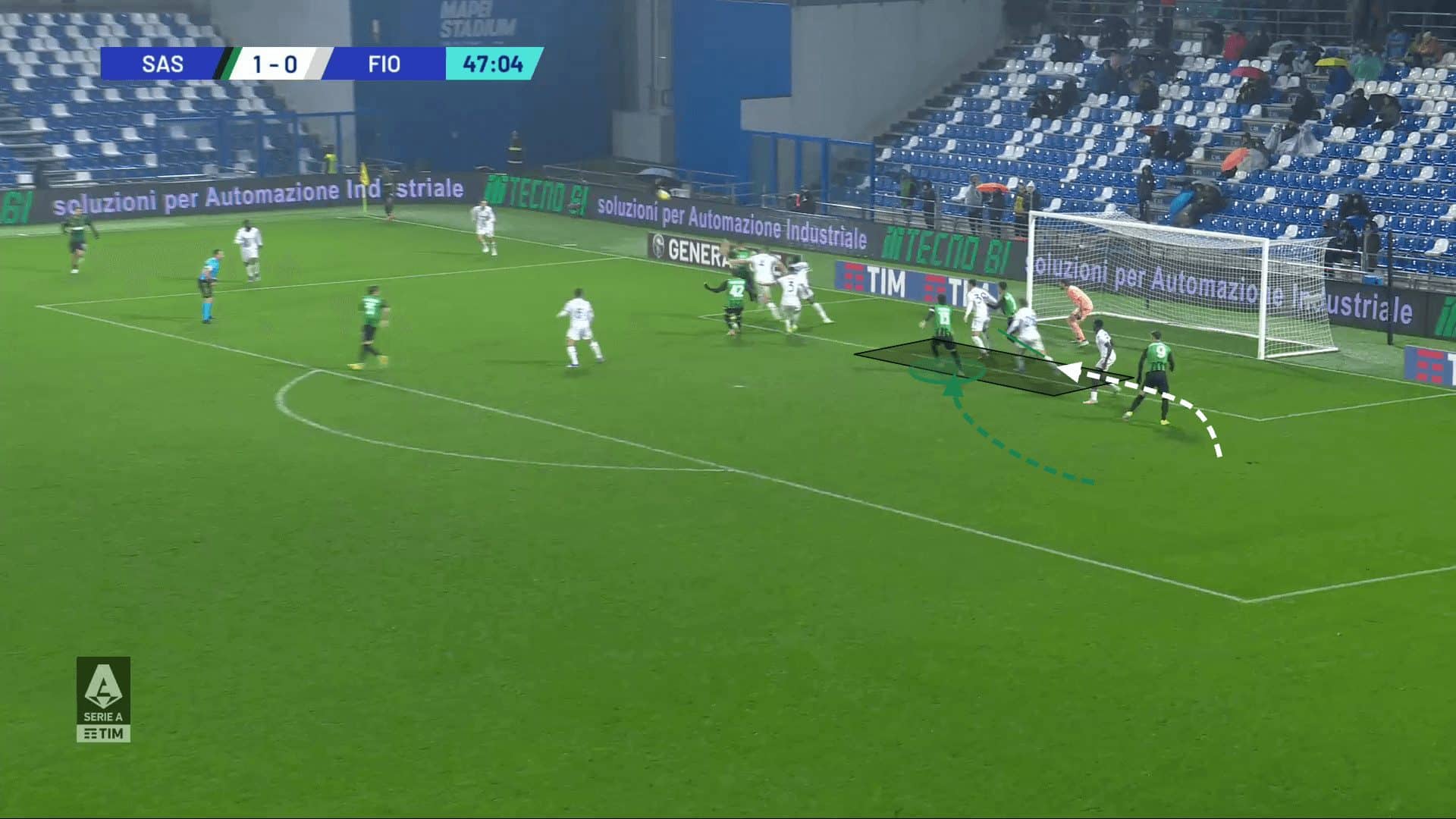
Conclusion
This set-piece analysis has demonstrated the ideas behind and benefits of some of the most innovative set-pieces used in Serie A in recent months. From the analysis, it is clear that teams facing man-marking defences have the most potential for exciting and creative set plays. In this article, you can find some proven set-piece routines that clubs worldwide could be using.






Comments